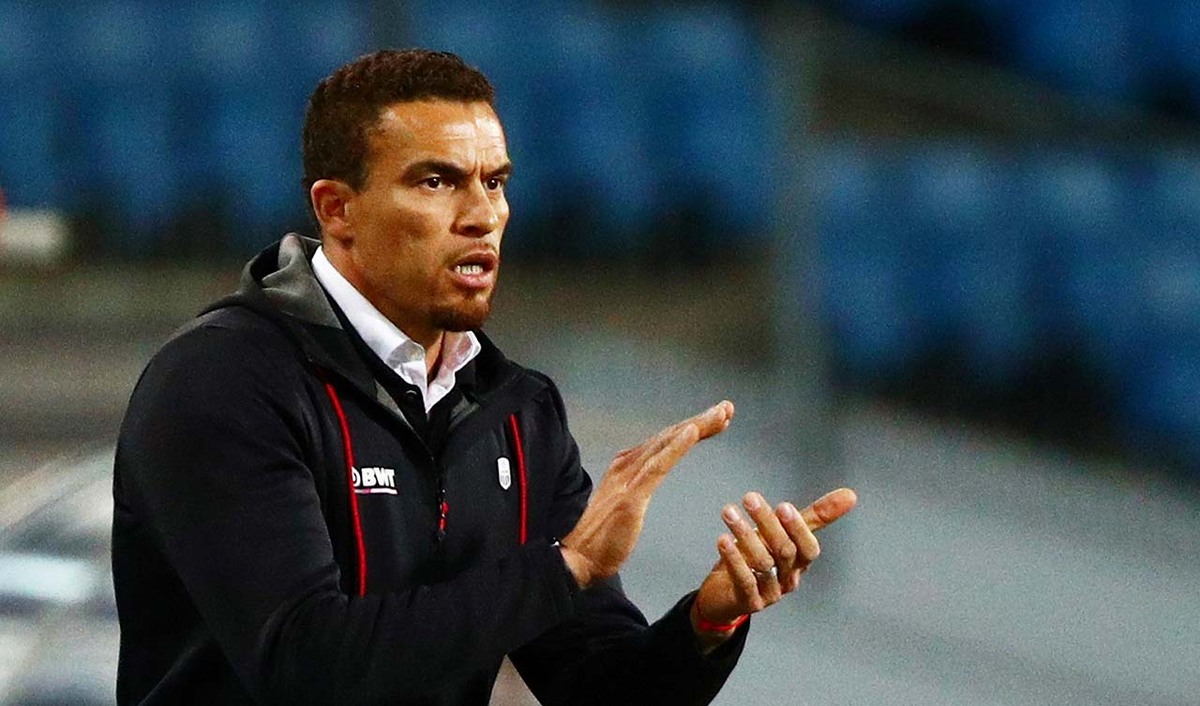You are viewing 1 of your 1 free articles
Direct attacking play with a purpose
This session is all about playing quickly forwards with purpose, followed by creative link up play to create scoring opportunities. To achieve this, the players need to demonstrate commitment, intensity of play and a desire to be one step closer to, and faster than, their opponents.
| Area | Up to full pitch |
| Equipment | Balls, bibs, cones, 2 goals |
| No. of Players | Up to 20 players + 2 goalkeepers |
| Session Time |
Direct play boxes: 10mins, Breakout 5v3: 12mins, Breakout 4v3: 12mins |
This session is all about playing quickly forwards with purpose, followed by creative link up play to create scoring opportunities. To achieve this, the players need to demonstrate commitment, intensity of play and a desire to be one step closer to, and faster than, their opponents.
This kind of intense and direct play starts right from the goalkeeper and includes every player on the pitch, so everyone has to participate here.
It’s very important that players choose the deepest option to play the ball to and that they find the correct pass during the game, playing it forward with quality and thought so the team retains possession and the opposition are kept under pressure. This allows us to create scoring opportunities or use our counter-press as an attacking weapon.
In these activities, we also focus on making quick combinations with each other in the build-up to the deep forward pass, so it is important that the players adopt the correct body shape and make quick but well-considered decisions.
We would run this session about once or twice a week, as it’s the basis for the way I like to play the game. It’s a part of the philosophy of the team.
DIRECT PLAY BOXES
We set up four 10x10-yard boxes around the centre circle, as shown. We’re using 20 outfield players split into five teams of four. Each box contains one possession team, arranged in a diamond formation. The remaining team are defenders and they start in the centre circle. Play begins with the coach serving the ball into a possession team in one of the boxes and two of the defenders can now enter the box to press. If the defending pair wins the ball and clears it or if it goes out of play, the coach serves a new ball to the opposite box, as shown [1a]. The team that gave away possession then have to transition and press the next active box, whilst the pressing team take their place. We play five games of two minutes.
1a
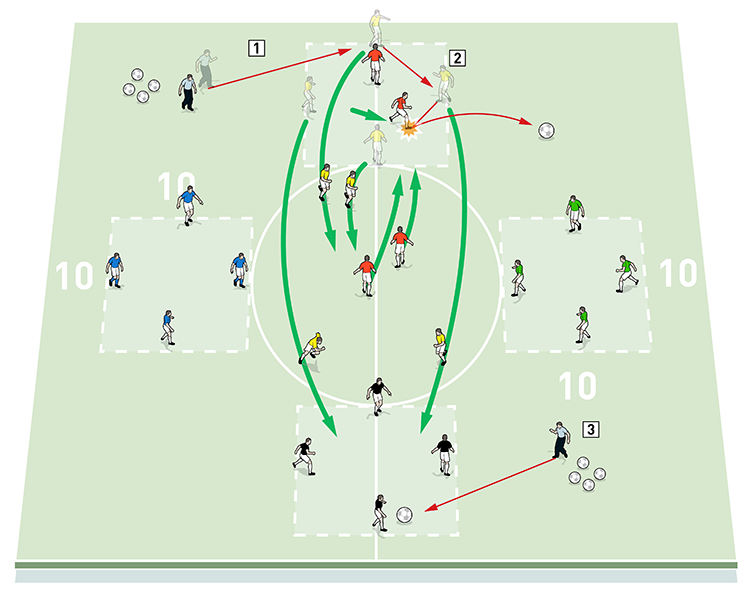
2. Two red defenders can now enter the box from the centre circle to press. If they win possession, as here, they clear it out of box and swap roles with the team that gave away the ball
3. The coach serves a new ball into the opposite box and the new pressing team enter the active box to press the possession team
The aim for the team in possession is to make five passes in the box before transferring the ball to another box. We discourage square passes and encourage the players to play to the furthest option safely. It is important the possession team prepares its structure and body shape to play first time after the five passes.
The player receiving the fifth pass should be looking in the direction that he is going to play the ball, as shown [1b]. We want to see players creating the space and finding the opportunity to pass forward first time with purpose by using clever movement and intelligent body shape.
1b
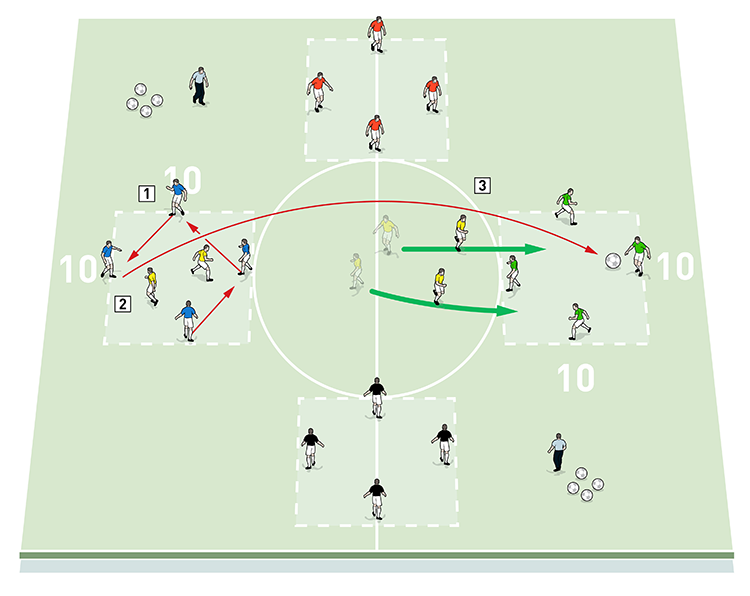
2. The player receiving the fifth pass must be looking in the direction he is going to play the ball. He then passes to the deepest player in the box he is facing
3. The two defenders in the centre circle are allowed to intercept the ball if they can. If not, they follow the ball into the box and press
If the ball is switched across the centre, the two defenders in the centre circle can intercept. If they fail, they follow the ball into the box and press.
BREAKOUT 5v3
We set up with a goal and a keeper at one end. We mark out two 10x10-yard boxes over the halfway line. We’re using 16 outfield players split into a blue defending team of six and red attacking team of 10. Four blue defenders start in one of the 10x10-yard boxes, along with two red attackers. The red attacking team are set up with a left winger, a left back, a central midfielder and a number 10 around the outside of the 10x10-yard box in their pitch positions. The red attacking team also has a striker and a right winger up the pitch, faced by two blue central defenders.
The blues start with the ball in the 10x10-yard box, passing to keep possession with a 4v2 overload in the box. When one of the two red pressers wins the ball, they quickly play forward with purpose to the striker. One blue defender from the 4v2 recovers to help his defenders, while the red number 10, the red left winger and a red midfield player all join the attack, making it 5v3 breakout, as shown [2a].
2a

2. When one of the two red pressers wins the ball, they play a quality pass up the pitch to the striker
3. One blue defender from the box recovers to help his central defenders
4. The red number 10, the left winger and a midfield player all join the attack, making it a 5v3 counter-attack
The reds attack using creative link up play and try to score, as shown [2b]. It is important the attacking team’s forward players take up the correct tactical positions. This enables a quick and direct transition. The defending team should try to halt the attack.
2b
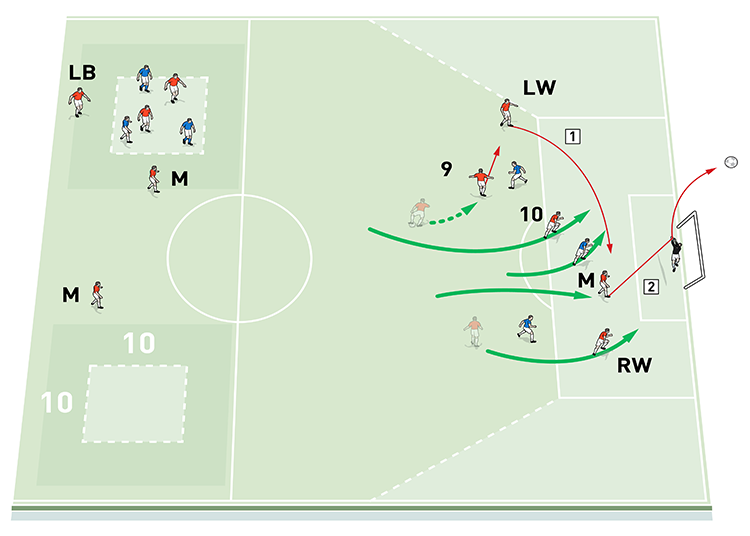
2. The reds must use creative link up play to attack and try to score in the goal
We play until the attackers have shot and then reset.We play six minutes on each side of the pitch.
BREAKOUT 4v3
We set up on a pitch with a goal and a keeper at each end. We mark a 15x15-yard box on the wing either side of the centre circle. We’re using 18 outfield players split into two teams of nine. Each team has three players in a 3v3 in one of the boxes, plus two players at the end they are attacking and two players at the end they are defending. Two players from each team also wait at the side for their turns to rotate in.
The coach starts by serving a ball into the 3v3 box. The team that wins the ball must create the opportunity to pass out of the box to their attacking players. They do this by using clever movement and intelligent body shape to make the space to play forward first time. The attacking team are supported by two team mates from the 3v3, who can break out to join the attack. As with all the activities, the players’ focus and mentality must be to play forward fast. One defender can also break out of the box to recover and help defend, as shown [3a].
3a
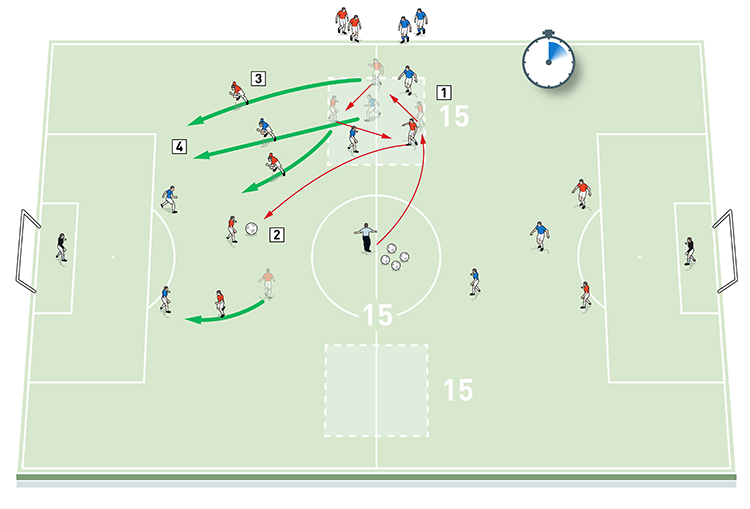
2. The team that wins possession must make a purposeful pass out of the box to their forwards and launch a quick attack on the opposition goal
3. The attacking team are supported by two team mates from the 3v3, who can break out of the box to join the attack
4. One defender can break out of the box to recover and help his team mates defend
Once the ball has been played out of the box, the team has just 10 seconds to score, so they must use quick and creative combination play.
If the ball is won by defenders or if the keeper saves, the defending team has one chance to transition the other way quickly. They should be looking to hit the furthest free player safely and then look to score in the opposite goal. It is important the forward players are positioned correctly for this to be effective. Their opponents will then look to counter-press and stop the transition. Once the attack is dead, the two breakout attackers are replaced in the 3v3 box by the team’s two waiting players, while the defending team replace their one breakout player, as shown [3b]. We then reset and play again. We play six minutes on each side of the pitch.
3b
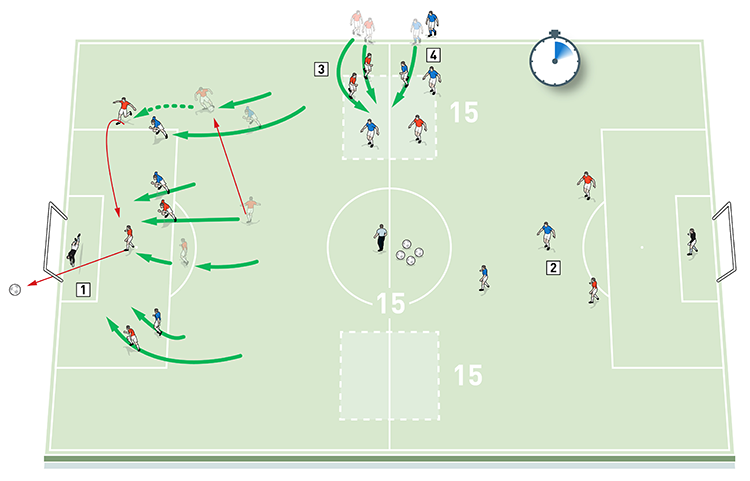
2. If the ball is won by defenders or the keeper makes a save, they must quickly transition the other way, hitting the furthest free player and trying to score in the opposite goal
3. Once the attack is dead, the two breakout attackers are replaced in the 3v3 box by the team’s two waiting players
4. The defending team replace their one breakout player and reset to play again
What are the key things to look out for?
We pay attention to body language and the overall behaviour of the team on the pitch. The players have a high degree of personal responsibility and pass this on internally in coaching sessions.
Our attackers always have to be vigilant, attack high and exert constant pressure.
What are the typical mistakes players might make and how do I avoid them?
Common mistakes can be, for example, the lack of intensity of an individual, which then has an immediate effect on the entire team. Of course, because of this, the walking routes for players are difficult at the beginning, but this is then clarified in a one-on-one conversation.
Related Files
Editor's Picks
Deep runs in the final third
Using the goalkeeper in build-up play
Pressing principles
Intensive boxes drill with goals
Penetrating the final third
Creating and finishing
My philosophy
Pressing initiation
Compact team movement
Coaches' Testimonials

Alan Pardew

Arsène Wenger

Brendan Rodgers

Carlos Carvalhal

José Mourinho

Jürgen Klopp

Pep Guardiola

Roy Hodgson

Sir Alex Ferguson

Steven Gerrard
Coaches' Testimonials

Gerald Kearney, Downtown Las Vegas Soccer Club

Paul Butler, Florida, USA

Rick Shields, Springboro, USA

Tony Green, Pierrefonds Titans, Quebec, Canada
Join the world's leading coaches and managers and discover for yourself one of the best kept secrets in coaching. No other training tool on the planet is written or read by the calibre of names you’ll find in Elite Soccer.
In a recent survey 92% of subscribers said Elite Soccer makes them more confident, 89% said it makes them a more effective coach and 91% said it makes them more inspired.
Get Monthly Inspiration
All the latest techniques and approaches
Since 2010 Elite Soccer has given subscribers exclusive insight into the training ground practices of the world’s best coaches. Published in partnership with the League Managers Association we have unparalleled access to the leading lights in the English leagues, as well as a host of international managers.
Elite Soccer exclusively features sessions written by the coaches themselves. There are no observed sessions and no sessions “in the style of”, just first-hand advice delivered direct to you from the coach.
